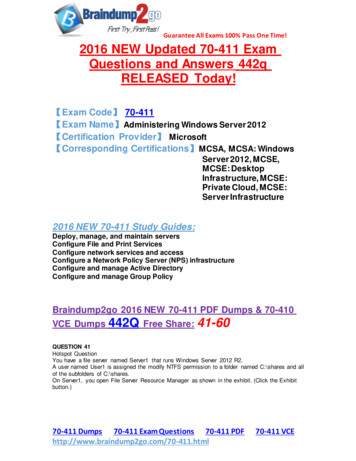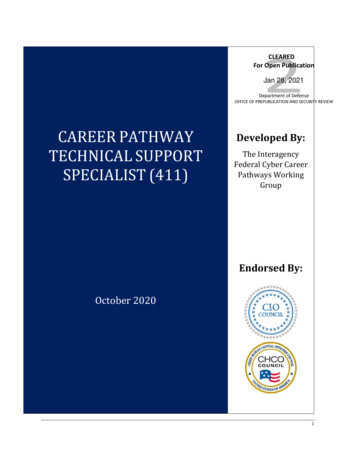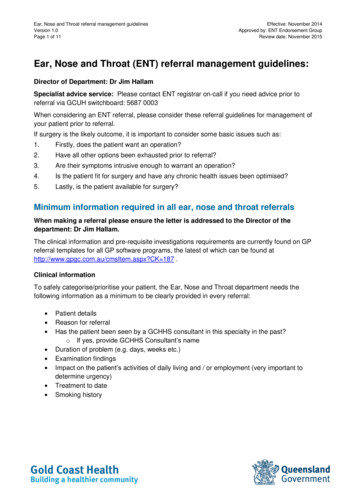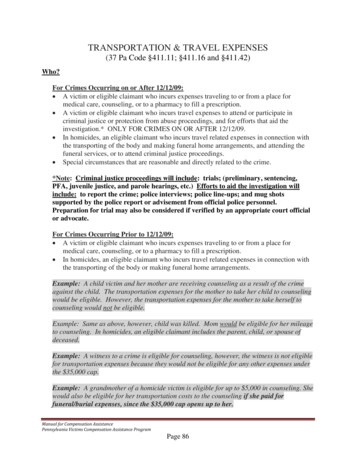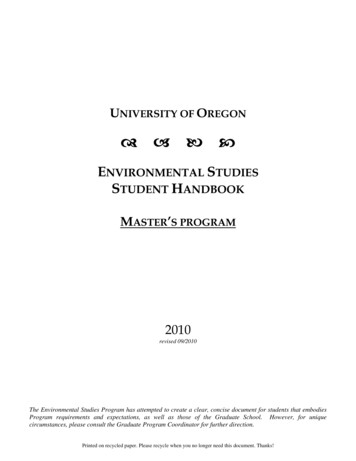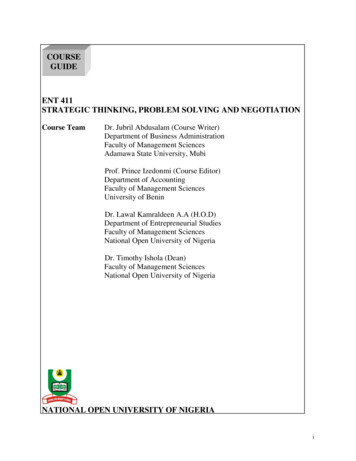
Transcription
COURSEGUIDEENT 411STRATEGIC THINKING, PROBLEM SOLVING AND NEGOTIATIONCourse TeamDr. Jubril Abdusalam (Course Writer)Department of Business AdministrationFaculty of Management SciencesAdamawa State University, MubiProf. Prince Izedonmi (Course Editor)Department of AccountingFaculty of Management SciencesUniversity of BeninDr. Lawal Kamraldeen A.A (H.O.D)Department of Entrepreneurial StudiesFaculty of Management SciencesNational Open University of NigeriaDr. Timothy Ishola (Dean)Faculty of Management SciencesNational Open University of NigeriaNATIONAL OPEN UNIVERSITY OF NIGERIAi
National Open University of NigeriaHeadquartersUniversity VillagePlot 91 Cadastral ZoneNnamdi Azikiwe ExpresswayJabi, Abuja.Lagos Office14/16 Ahmadu Bello WayVictoria Island, Lagose-mail: centralinfo@noun.edu.ngURL: www.noun.edu.ngPublished by:National Open University of NigeriaISBN:Printed: 2017All Rights Reservedii
CONTENTSIntroductionCourse ContentsCourse AimsCourse ObjectivesWorking through This CourseCourse MaterialsStudy UnitsTextbooks and ReferencesAssignment FileAssessmentTutor-Marked AssignmentFinal Examination and GradingHow to get the Best out of this CourseFacilitators/Tutors and TutorialsUseful AdviceSummaryiii
IntroductionStrategic Thinking, Problem Solving and Negotiation Skills is a one semester course forstudents offering B.Sc Entrepreneurship Studies at the 400 level. This is a 2 unit courseconsisting of five (5) modules with units in each module. It‘s a core course at this level. Thiscourse guide informs and allows students to know briefly what the course is about, what coursematerial you will be using and how these materials would be used. It also highlights issues ofrelevant points for you to go through these units in the modules, and explains the activities andTutor-marked Assignment. There are supposed to be tutorials attached to this course and takingadvantage of this will bring you into contact with your tutorial facilitator which will enhanceyour understanding of the course.What You Will Learn in this CourseThis course is designed to develop the right mindset in students to challenge the status quo anddevelop the right attitude to build innovation organizations. You will learn Strategic thinkingwhich includes finding and developing a strategic foresight capacity for an organization, byexploring all possible organizational futures, and challenging conventional thinking to fosterdecision making today. You will rethink to let you think out of box for your organisation.Topicsyou will cover among others; an overview of the traditional thinking process (horizontal),Strateg-y, types of strategy, tools and its strengths and weaknesses; lateral thinking perspective; analysisof different views about thinking; the interface among thinking, problem Solving and Negotiation skills.Course AimsThis Strategic Thinking, Problem Solving and Negotiation Skills course is for students who willbe involved in developing or implementing strategy for organisations. It will explore what youcan do to ensure that you are most useful thoughts are translated into practical plans and effectivebehaviours to make you re-think and take decisions at critical level.iv
Thinking creatively around innovation, to stages of planning and finally communicating thevision to others, the steps of effective strategic planning to achieve grounded and measurableresults is very important. Students leave this course with practical, concrete and usable planswhich will be useful and implemented with confidence.The aim of this course as pointed out earlier is to expose the students to the concept of strategicthinking. This will be achieved by aiming to:* Introduce you to the basic concepts and elements of strategic thinking* Issues in lateral thinking techniques, vertical and horizontal linkages with win relationships inthe organization* Give an insight in Strategic leadership and strategic planning system in the organization amongothers*Understand and solve strategic problems using necessary steps*Understand negotiation skills and the interface among strategic thinking and problem solvingtechniques.* Understand the need to rethink and strategically think out of box- Unconventional ways ofsucceeding in business using critical thinking strategies.Course ObjectivesTo achieve the aims set out above the overall course objectives should be attended to. InAddition, each unit also has specific relevance to the study. The unit objectives are alwaysincluded at the beginning of a module. You are advised to refer to them as you study each unitboth at the beginning and end of the unit to ensure that you check your progress and that youhave done what is required of you by the unit.Working through This CourseTo complete this course you are required to read, the study units and recommended textbooksand explore more current materials on the Internet for best results. In this course, each unitconsists of exercises or activities to test your understanding from time to time. At a point in yourv
course, you are required to submit assignments for assessment purposes. At the end of thecourse, is a final examination.Below you will find listed all the components of the course, what you have to do and how youshould allocate time to each unit in order to complete the course successfully on time.Course MaterialsMajor components of the course are:1. Course Guide2. Study Units3. Further readings4. Activities and Tutor-marked Assignments.Study ModuleThere are five modules (5) with units in this course material as follows:Module1-IntroductionUnit 1.1 Definition of Strategic ThinkingUnit 1.2 Elements of Strategic ThinkingUnit 1.3 Importance of Strategic Thinking to BusinessUnit 1.4 Ways to Improve Strategic Thinking SkillsUnit 1.5 Role of Strategic Thinking in Business PlanningUnit 1.5.1 Strategic Thinking ProcessUnit 1.5.2 Strategic Thinker: Test yourself.Unit1.6 Strategic Planning and Organising SkillsUnit1.6.1 Organising SkillsUnit1.6.2 Effective Organising Skills: The following Seven Steps are explained.Unit1.6.3 Strategic Thinking and PlanningUnit1.6.4 Project Management for LeadersUnit1.6.5 Managing RiskUnit1.7 Simplified Strategic PlanningUnit1.7.1 Simplified Strategic Planning Process Structurevi
Unit1.7.2 Sound Strategy Effective Implementation Solid SuccessUnit1.8 Principles of Strategic LeadershipUnit1.9 Common Challenges to Strategic PlanningUnit1.9.1 Pitfalls in Strategic PlanningUnit1.10 Strategic Innovative Thinking into CompanyUnit1.10.1 Strategy SettingUnit1.10.2 Structure of Innovative ThinkingModule 2Unit 2.0 IntroductionUnit2.1 Definition of StrategyUnit2.2.1 Corporate StrategyUnit2.2.2 Business Unit StrategyUnit2.2.3 Team StrategyUnit2.3 Intensive StrategiesUnit2.3.1Market PenetrationUnit2.3.2Market DevelopmentUnit2.3.3 Product DevelopmentUnit2.3.4 Diversification StrategiesUnit2.4 Strategic Situation AnalysisUnit2.5 PEST Model AnalysisUnit2.6 SWOT ANALYSIS AND PROFILESUnit2.6.1 How to Identify Strengths and Weaknesses in a Business PlanUnit2.6.2 Best way to complete the analysisUnit2.6.3 what is the point of completing a SWOT analysis?Unit 2.6.4 What to Do-Know Your StrengthsUnit 2.6.5 Recognize Your Weaknessesvii
Unit2.6.6 Spot the OpportunitiesUnit 2.6.7 Watch Out for ThreatsUnit2.6.8 Use Your AnalysisUnit2.6.9 Examples of Weaknesses in SWOT AnalysisUnit2.7 Suggested Textbooks for Further ReadingUnit2.8 Assignment FileUnit2.9 Tutor Marked AssignmentsModule 3Unit3.0 Introduction to Lateral ThinkingUnit 3.1 what is Lateral Thinking?Unit3.2 Lateral Thinking TechniquesUnit 3.3 Vertical, Horizontal or Lateral. Which Way to Market?Unit3.3.1 Application of the Lateral Marketing ProcessUnit3.3.2. Importance of lateral and vertical marketingUnit3.4. Importance of Vertical and Horizontal Linkages to Foster Win-Win Relationshipsin BusinessUnit3.5. Understand the Elements and Thinking Modes that Create Fruitful Ideation Sessionsviii
Unit3.5.1 Mental or Thinking ModesUnit3.5.2 Vertical Thinking – Linear ThinkingUnit3.5.3 Binary ThinkingUnit3.5.4 Lateral Thinking – Horizontal ThinkingUnit3.5.5 Provocations in Lateral ThinkingUnit3.5.6 Disruptive ThinkingUnit3.6 .7 Three modes of thinking in Ideation SessionsUnit3.7 How to Develop Critical ThinkingUnit3.7.1 Learn How to Use the Best Ideation Methods and Idea Selection: SCAMPERUnit3.7.2 Idea Selection – Apply Edward De Bono's Six Thinking HatsUnit3.7.3 ConvergingUnit3.7.4 Four Categories MethodUnit3.7.5 Idea Affinity DiagramsUnit3.7.6 Idea Selection CriteriaUnit3.8 Guide to Idea Management ProcessesUnit3.9 Interface of Vertical versus Lateral ThinkingUnit3.10 How lateral thinking can help us find better ideasUnit3.11 References/Suggestions for Further ReadingUnit3.12 Tutor Marked Assignmentsix
Unit 3.13 Assignment filesModule 4Unit4.0 Introduction to Problem Solving SkillsUnit4.1 Definition of Problem SolvingUnit4.2 Tools for Understanding ProblemsUnit 4.2.1 Five Whys Getting to the Root of a Problem QuicklyUnit4.2.2 Cause and Effect Analysis in Solving ProblemUnit 4.2.3 Brainstorming Can Generate Many Radical, Creative Ideas to Solve ProblemsUnit4.3 How to Make Better DecisionsUnit4.3.1 The Importance of Creative Problem Solving in Business and LifeUnit4.3.2 Critical Thinking in the Decision Making Process to Solve ProblemsUnit4.3.3 Methods and Techniques for Problem Solving and Decision MakingUnit4.3.4 Steps in Problem Solving MethodUnit4.3.5 PEST – Analysis Political Economic Social TechnologicalUnit4.3.6 SWOT Analysis – Strengths Weakness Opportunity ThreatsUnit4.3.7 FMEA AnalysisUnit4.4. Seven Steps Problem Solving Techniques: what‘s the problem?Unit4.5 Five Ways to Enhance Your Problem Solving SkillsUnit4.6 The Simplest Ways to Improve Your Problem Solving SkillsUnit4.6 The skills of problem solvingUnit4.6.1 Why people fail to solve problems effectivelyx
Unit4.6.2 The Road to a Solution – Using models to represent a problemUnit4.6.3 How to Become a Better Problem SolverUnit4.6.4 Guidelines to Problem Solving and Decision MakingUnit4.7 Various Tools and Methods for Problem Solving and Decision MakingUnit4.8 Solving Problems using a group - advantages and disadvantagesUnit4.9 Creative Problem Solving Leads to Organisational InnovationUnit4.10 Assignment FileUnit4.11 Tutor-Marked AssignmentUnit4.12. References/Suggestion for Further ReadingMODULE 5Unit 5. O Introduction to NegotiationUnit 5.1 Definition of NegotiationUnit5.2 Elements of NegotiationUnit5.3 Importance of Negotiation in Corporate OrganisationUnit5.4 Techniques of NegotiationUnit5.5 CONDITIONS FOR NEGOTIATIONUnit5.6 Why Parties Choose to NegotiateUnit5.6.1 Why Parties Refuse to NegotiateUnit5.7 Dynamics of Negotiationxi
Unit5.8 Building negotiation capability in an organisationUnit5.8.1 Negotiation as a core competencyUnit5.9 Negotiation Skills for ManagersUnit5.10 Role of Communication in NegotiationUnit5.10.2 Role of Emotions in NegotiationUnit5.10.3 Tips for Professionals for a Successful NegotiationUnit5.11 References/Suggestion for Further ReadingUnit5.12 Assignment FileUnit5.13 Tutor-Marked AssignmentTextbooks and ReferencesThere are no compulsory textbooks for this course. However as you go through the course, youwill observe that some textbooks are suggested and majority of works came from onlinematerials which are very relevant to this course. This shows that it is crucial to a number of units.Assignment FileThe major assignment required of you is a Tutor-Marked Assignment (TMA) which you areexpected to complete at the end of each module and mail it to your tutor.AssessmentYour assessment for this course is made up of two components Tutor-marked Assignment: 40%Final Examination: 60%xii
Total score:100%The practice exercises (or activity) are not part of your final assessments, but it is important tocomplete all of them. If you do the practice exercises, it will facilitate your understanding of thesubject matter or topics and your TMA. Tutor-Marked Assignments (TMAs); each unit of thiscourse has a TMA attached to it. You can only do this assignment after covering the materialsand exercise in each unit.Normally the TMA are kept in a separate file. Your Tutor will mark and comment on it. Payattention to such feedback from your Tutor and use it to improve your other assignments.You can write the assignments by using materials from your study units and from textbooks orother sources. You should demonstrate evidence of wide reading especially from texts and othersources, something to show that you have read widely.The assignments are in most cases essay questions. Examples from your own experience, thismaterial or environment that is useful when you answer such questions. This allows you to applytheory to real life situations.ConclusionStrategic Thinking, Problem Solving and Negotiation Skills is a new and an interesting coursethat allows you to think strategically out of box. To let you decide how and when to take adecision that is vital at a critical moment of your business life without following due moderationssometimes. It provides you an ample opportunity to know what it takes in an individual‘s life toexecute tasks using critical thinking and negotiation processes.It can simply be seen to as a finding and developing strategic foresight capacity for anorganization, by exploring all possible organizational futures, and challenging conventionalthinking to foster decision making today.xiii
MODULE 1Module ObjectivesAt the end of these units, you should be able to:-Define and understand strategic thinking-Understand strategic thinking elements and its importance to business-Understand strategic planning and organising skills-Understand strategic thinking process and strategic innovative thinking into company1.0 IntroductionIn this unit an attempt is made to present the basic idea about Strategic Thinking. This includesthe philosophy and mindset, the need for strategic leadership in an organisation and issues ofstrategic planning, its challenges, and structure of innovative thinking. A student will need tounderstand these to be able to appreciate specific issues that will follow in subsequent units. Itwill include definitions and relevant strategic issues and skills that will be discussed here below.Strategic thinking is seen differently by different theorists, and some of those explanations ofdefinitions are more research oriented and academic than we might like if we want to providepractical guidance about strategic thinking in the real world. Before looking at the more abstractside, let's provide a simple (and perhaps overly simplistic perspective on strategic thinking).Strategic thinking is a MINDSET or way of thinking about a business or organization. It can bedistinguished, strategic thinking by several characteristics. Focuses on long term rather than short term Involves systems thinking, and focusing on the big picture, NOT just the small one Focuses on identifying leverage (how can we use what we have to maximum advantage) Is both analytical, and creative processes Involves exiting assumptions, "the way things have been done around here", and a criticalapproach that questions what we believe.1
Takes into account that our thinking is going to be partly based on inaccurate informationand/or conclusions, and treats any conclusions as tentative or hypotheses.Strategic thinking includes finding and developing a strategic foresight capacity for anorganization, by exploring all possible organizational futures, and challenging conventionalthinking to foster decision making today. Beaufre wrote in 1963 that strategic thinking "is amental process, at once abstract and rational, which must be capable of synthesizing bothpsychological and material data. The strategist must have a great capacity for both analysis andsynthesis; analysis is necessary to assemble the data on which he makes his diagnosis, synthesisin order to produce from these data the diagnosis itself--and the diagnosis in fact amounts to achoice between alternative courses of action.‖There is no generally accepted definition for strategic thinking, because no common agreementas to its role or importance, and no standardised list of key competencies of strategic thinkershave been agreed upon by experts in the area of study. There is no consensus on whetherstrategic thinking is an uncommon ideal or a common and observable property of strategy. Mostagree that traditional models of strategy making, which are primarily based on strategic planning,are not working. Strategy in today's competitive business landscape is moving away from thebasic ‗strategic planning‘ to more of ‗strategic thinking‘ in order to remain competitive.However, both thought processes must work hand-in-hand in order to reap maximum benefit. Ithas been argued that the real heart of strategy is the 'strategist'; and for a better strategy executionrequires a strategic thinker who can discover novel, imaginative strategies which can re-write therules of the competitive game; and set in motion the chain of events that will shape and "definethe future".When applied in an organizational strategic management process, strategic thinking involves thegeneration and application of unique business insights and opportunities intended to createcompetitive advantage for a firm or organisation. It can be done individually, as well ascollaboratively among key people who can positively alter an organization's future. These are theleaders or managers of a firm. Group strategic thinking may create more value by enabling aproactive and creative dialogue, where individuals gain other people's perspectives on criticaland complex issues. This is regarded as a benefit in highly competitive and fast-changing2
business landscapes.1.1. Definition of Strategic ThinkingAccording to Mintzberg (1994), explained that strategic thinking is more about synthesis (i.e.,"connecting the dots") than analysis (i.e., "finding the dots"). It is about "capturing what themanager learns from all sources (both the soft insights from his or her personal experiences andthe experiences of others throughout the organization and the hard data from market research andthe like) and then synthesizing that learning into a vision of the direction that the business shouldpursue." Mintzberg argued that strategic thinking cannot be systematized and is the critical partof strategy formation.Strategic thinking is a process that defines the manner in which people think about, assess, view,and create the future for themselves and others. Strategic thinking is an extremely effective andvaluable tool one can apply to arrive at decisions that can be related to his/her work or personallife (Bradford, 2016).This definition is critical to an entrepreneur who must think towardssuccess in his/her business. It‘s about looking at the environment, assessment of certain profilesthat are important to the success of the business; view the possible threats in the business andpossibly thinking towards the creation of opportunities for their businesses.The greatest and most successful organizations in the world, over many years and decades,would think ahead and encourage great strategic thinking at least somewhere in their businessplans. A sustainable successful future requires much more, no matter how big or small yourbusiness is, and a major requirement is strategic thinking.Strategic Thinking lies perhaps at the core of strategic process. That‘s starting from StrategicThinking; to Environmental Factors; to Analysis; to Strategic Choice. However; the idea of―Strategic Thinking‖ still appears to be abstract. In the context of the business environment,strategy process includes an analysis of the contingencies of the political, social, economic,technological and legal environment; generation of alternatives; and an appropriate strategicchoice matching the organizational strengths and weaknesses with the environmentalrequirements. This involves two sub-processes:3
1. Generation of strategic alternatives and2. Choosing from among strategic alternatives.A lot of strategic choices are generated around the key strategic questions: who are the firm‘scustomers, what products is the firm offering, and how will it offer these products. Strategicthinking requires creativity and innovation in generating alternative strategic choices. But moreimportantly, it also requires exercising a choice from amongst alternatives. The question is howone exercises a choice. Modern strategy management gives us the techniques of understanding,not of choosing. Surprisingly, not much work has been done to understand what goes on in themind of the person who takes strategic decisions (Amitah, 2016).Typically, strategic thinking is defined by game theorists as the art of outdoing an adversary,knowing that the adversary is trying to do the same to you. This is the central theme of gametheory which deals with decision situations in which two intelligent opponents with conflictingobjectives are trying to outdo one another (Taha, 2007). Each player will have a finite or aninfinite number of alternatives or strategies. Associated with each pair of strategies is a payoffthat one player receives from the other. In effect it is a zero-sum game where one player‘s gainsignifies an equal loss to the other.Strategic thinking involves making a series of decisions about what actions the company intendsto take to become more successful. A company often goes through a strategic planning processonce a year, creating a document that is, in essence, a guidebook for the management team to usein the upcoming year. Companies should strive to make strategic thinking an ongoing, yearround process. At the heart of strategic thinking is the ability to anticipate major shifts in thecompetitive marketplace and identify emerging opportunities.1.2 Elements of Strategic ThinkingThese are the five elements that make up strategic thinking as described by Dr. Jeanne M.Liedtka, a faculty member at the University of Virginia‘s Darden Graduate School of Businessand former chief learning officer at United Technologies Corporation. She wrote an article* to4
explain what it meant to think strategically. So what are these five essential elements of strategicthinking that she identified? The following are the elements and their explanations.1. Intent focusedLiedtka says: ―Strategic intent provides the focus that allows individuals within an organizationto marshal and leverage their energy, to focus attention, to resist distraction, and to concentratefor as long as it takes to achieve a goal.‖ This concept implies both having an overarching goalor direction (you might call that your vision) and making that goal a conscious focus or, in thiswonderful definition for intent I found online ―the act of turning your mind toward‖ an outcomeor object.In this approach to our matter, this intent is the change that we want to see in the world. Achange that we are completely passionate about, that channels our every action for the future.Probably, the future of your business as it covers from start up to growth while making profits.2. A systems perspectiveThink ecosystem. An exercise I do with my graduate students that you can try for yourorganization is to describe all of the various systems in which you exist. Their answers start withthe classroom and move beyond to the higher education system, to legal, natural, family, or bodysystems, to global economic and financial systems — and they operate in all of them.So does your organization. So, to get good at strategic thinking, you need to try to understand theway your world works and how that affects you. Because you cannot really know everything,you will have to take your best shot at gathering the right information and prioritizing thecomponents of systems that are most likely to affect the way you work now and into the future.It really does help though to be curious about just about everything. While you might be anexpert in interpreting the particular ―business ecosystem‘ in which you operate, how well do youunderstand what is happening culturally or politically that might also influence your future?Read a lot. Explore new things. Talk to people outside your organization and outside yourdiscipline as well as the people who know your system the best.5
3. Thinking in TimeLiedtka suggests strategic thinkers ask this question: ―Having seen the future that we want tocreate, what must we keep from our past, lose from that past and create in the present to getthere?‖When you think strategically, you are always connecting the past to the present and to the future.You learn from the past and use that learning to make predictions. You look at the present toassess the gap between where you are now and where you want to end up. While your focus isalways on the future, you can only act in the present. This concept always makes you think ofwell and mindful of time.4. Intelligent OpportunismRemember the old exercise, the SWOT analysis (Strengths, Weaknesses, Opportunities, andThreats.) Well, SWOT thinking never ends for strategic thinkers. Strategic thinkers are able tospot and react to great new opportunities as they arise. They understand that the world isdynamic and they are open to change to reach their vision.Intelligent opportunism also implies that you dig deep into your organization to hear from manyperspectives. Ideas and knowledge are valuable wherever they exist — but you will need to lookand listen to benefit from them.5. Hypothesis drivenFinally, Liedtka says, ―strategic thinking mirrors the scientific method it is both creative andcritical in nature.‖ As strategic thinkers, we create hypothesis, those questions that start ―Whatif ?‖ Or ―If then?‖ - Questions that enable us to imagine multiple scenarios, analyze them asbest we can based on the knowledge we have accumulated and then test the best hypotheses(experiment). As we act, we learn from our experience to create new hypothesis for future action.Thus, strategic thinking dissected and explained.6
1.3 Importance of Strategic Thinking to BusinessStrategic thinking helps your business achieve its goals more rapidly. Success comes as a resultof thinking about how you can proactively accomplish your objectives instead of just reacting tobusiness conditions. A strategic mind-set also encourages you to determine the best use ofresources at your disposal and how to align them with your action plan. The following pointscould lead you to success in doing your business.1. Missing OpportunitiesStrategic thinking helps you recognize and take advantage of windfall opportunities. If you'realways thinking about what problems your company faces, you have little time left to plan forthe future. Windfall opportunities are those that could result in rapid business growth, such as achance to recruit away disgruntled workers from your competitor or buy out inventory from acompetitor's liquidation sale.2. Focusing on Problem SolvingStrategic thinking also encourages you to take a long view of your company's business modeland operations. Your company could have persistent operational problems that prevent it frommaximizing success, so you and your employees must think critically about the root causes ofproblems. For example, you could study overhead costs such as printing, looking for the corereasons why your business wastes paper and toner. Then you can revise your policies andprocedures so printing is no longer a drain on your overhead budget.3. Creating a Clear StrategyEmployees also benefit from the strategic mind-set of a small-business owner. A businessstrategy should clearly explain to employees what roles they play in reaching company goals.Some strategic plans are short term, outlining how your company will achieve an end goal in afew months' time. Other plans, such as your strategic plan, explain how your company willrealize long-term goals over five or 10 years.7
4. Being ProactiveIf you are planning ahead and addressing present business conditions simultaneously, you canchoose appropriate actions when the economy shows early signs of trouble. Plan for how yourbusiness will succeed in tougher times. If consumer demand is decreasing or supply costs arerising, you can begin cutting costs in your overhead budget, ensuring that your overhead will notcripple you when the market declines. Without a deliberate strategy, your business decisions willbe reactive instead of proactive.5. Resource LimitationsDealing with limited resources of money, people and time is a fact of life for all businesses, evengiant corporations. Strategic thinking enables a business owner to determine how to use theseresources most effectively and advance the company toward its objectives. Strategic thinkingfocuses the management team on markets that are most likely to succeed. Strategic thinkinghelps the company avoid costly mistakes, such as opening a new retail location before thecustomer population is large enough to support it.6. Changing EnvironmentEvery business is affected by change. New competitive threats arise. Change in the national andlocal economy affect the spending power of a company and customers. The prices of materials orinventory rise unexpectedly. The environment creates opportunity, too. New markets open up.Competitors that falter can create an opportunity to take market share from them. Strategicthinking is a mindset of preparing for these changes and having plans in place to deal with them.Reacting quickly allows the company to take advantage of opportunities and minimize thedamage of unforeseen negative events.7. Matching Competitors and StrengthsBusiness has been compared to a game of chess, with strategic moves of the chess piecesdetermining the outcome. The analogy is only partially accurate, because in business each sidedoes not start with the same number of pieces, and the size of the board constantly changes.8
Compa
Unit 1.4 Ways to Improve Strategic Thinking Skills Unit 1.5 Role of Strategic Thinking in Business Planning Unit 1.5.1 Strategic Thinking Process Unit 1.5.2 Strategic Thinker: Test yourself. Unit1.6 Strategic Planning and Organising Skills Unit1.6.1 Organising Skills Unit1.6.2 Effective Organising Skills: The following Seven Steps are explained .




